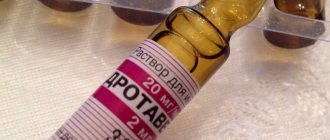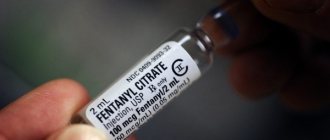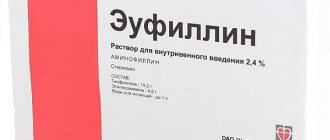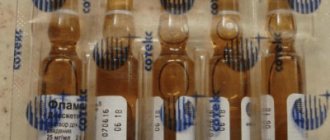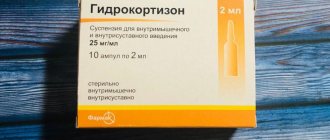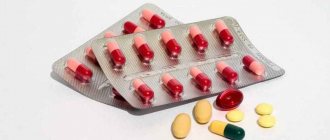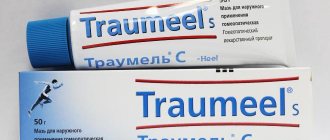pharmachologic effect
Reducing peripheral vascular resistance with Ebrantil leads to a balanced decrease in systolic and diastolic blood pressure without changing heart rate.
Urapidil increases the reduced cardiac output to a stable value and thereby improves cardiac economy.
The active substance has peripheral (vascular) and central (affecting central regulatory mechanisms) effects.
The peripheral effect is the blocking of postsynaptic alpha-1 receptors, which leads to inhibition of the vasoconstrictor effects of catecholamines and vasodilation of peripheral vessels.
Centrally modulates the activity of regulatory centers of the blood circulation, preventing an increase in sympathetic tone accordingly. This effect is due to stimulation of 5-HT receptors in the spinal cord.
Pharmacokinetics
After oral administration, 80-90% of the substance is absorbed in the gastrointestinal tract. About 80% of urapidil is bound to plasma proteins.
The absolute bioavailability of urapidil from controlled-release capsules compared to the IV standard averages 72% (63-80%).
The relative bioavailability of capsules compared to an orally administered solution is 92% (83-103%).
Peak plasma concentrations are achieved 4-6 hours after oral administration, with an average plasma half-life of 4.7 hours. (3.3-7.6 hours).
Urapidil is mainly metabolized in the liver.
Ebrantil and its derivatives are excreted from the body by 50-70% by the kidneys (of which 15% is the pharmacologically active urapidil). The rest is excreted in the feces.
Ebrantil
Active substance:
Urapidil*
Pharmgroup:
Alpha blockers
Analogs for the active substance:No data on synonyms | Application area:Vasorenal hypertension Sudden increase in blood pressure Sudden increase in blood pressure Hypertensive circulatory disorder Hypertensive circulatory disorder Hypertensive state Hypertensive state Hypertensive crises Hypertensive crises Hypertension Hypertension Arterial hypertension Arterial hypertension Hypertension is malignant Hypertension is malignant Hypertension, symptomatic Essential hypertension Hypertonic disease Hypertensive crises Hypertensive crises Hypertensive crisis Hypertensive crisis Hypertension Purulent complications in the postoperative period Purulent complications of surgical operations Malignant hypertension Malignant hypertension Malignant hypertension Malignant hypertension Malignant hypertension Isolated systolic hypertension Isolated systolic hypertension Hypertensive crisis Hypertensive crisis Hypertensive crisis Exacerbation of hypertension Exacerbation of hypertension Primary arterial hypertension Postoperative liver dysfunction Postoperative vomiting Postoperative complications Postoperative period Renal hypertension Early postoperative period Renovascular arterial hypertension Renovascular hypertension Renovascular diseases Symptomatic arterial hypertension Transient arterial hypertension Transient arterial hypertension Essential arterial hypertension Essential arterial hypertension Essential hypertension Essential hypertension |
Side effects
Dizziness, nausea, or headache may sometimes occur as a result of low blood pressure. These side effects usually occur at the beginning of treatment and disappear spontaneously with further therapy.
Rarely, fatigue, dry mouth, nasal swelling, sleep disturbances, gastrointestinal complaints (vomiting, diarrhea), allergic symptoms (itching, skin flushing, rash), tachycardia or bradycardia, chest pain or nausea, decreased blood pressure, may occur. when body position changes from lying to standing (orthostatic dysregulation).
In rare cases, increased urge to urinate or increased urinary incontinence, priapism, edema (water retention) and a reversible increase in liver enzymes have been reported.
In isolated cases, a decrease in platelet counts has been reported in association with the use of urapidil, but a causal relationship with Ebrantil has not been proven by immunohematological studies.
Interaction with other drugs
Concomitant use of alpha-adrenergic receptor blockers and other antihypertensive agents, consumption of alcoholic beverages, and conditions with reduced fluid levels in the body (diarrhea, hot flashes) may enhance the antihypertensive effect of the drug.
Serum concentrations of the drug may be increased by up to 15% when administered concomitantly with cimetidine. In the absence of sufficient information regarding the combined use of Ebrantil and ACE inhibitors, the combination is currently not recommended.
Application and dosage
Ebrantil extended-release capsules should be taken morning and evening with meals.
To gently lower blood pressure, start with 30 mg twice daily (equivalent to 30 mg urapidil twice daily).
If a more rapid reduction in blood pressure is desired or necessary, treatment can also be started with 60 mg twice daily (equivalent to 60 g urapidil twice daily).
The dose can be gradually adapted to individual needs.
The dose range for maintenance therapy is 60-180 mg urapidil per day, with the total amount divided into two separate doses. Ebrantil delayed-release hard capsules are available for this purpose in 30 mg, 60 mg and 90 mg.
Dose reduction may be required in patients with liver impairment.
In moderate to severe renal impairment and in the elderly, long-term treatment may require dose reduction.
Contraindications
Contraindications to the use of Ebrantil are:
- Pregnancy;
- Adolescence up to 18 years of age;
- Lactation period;
- Hypersensitivity to the active (urapidil) or auxiliary components included in the tablets and injection solution.
Particular caution must be observed when using Ebrantil simultaneously with cimetidine, in elderly people, and also against the background of:
- Myocardial contractility disorders due to pericardium;
- Chronic heart failure;
- Liver dysfunction;
- Stenosis of the aortic and mitral valve;
- Pulmonary embolism;
- Moderate to severe renal failure.
Overdose
Drug poisoning may include the following symptoms: dizziness, orthostatic hypotension, collapse, fatigue, slow reaction time.
Inadequate response to antihypertensive therapy may mainly be caused by lower extremity elevation and fluid replacement.
If these measures are not sufficient, drugs with a vasoconstrictor effect should be administered (slowly intravenously) with constant monitoring of blood pressure.
In very rare cases, intravenous administration of catecholamines is required (adrenaline 0.5-1.0 mg in 10 ml of isotonic sodium chloride solution).
Instructions:
Clinical and pharmacological groups
01.048 (Antihypertensive drug) 01.007 (Alpha1-blocker)
Release form, composition and packaging
The solution for intravenous administration is transparent, colorless.
| 1 ml | 1 amp. | |
| urapidil hydrochloride | 5.47 mg | 27.35 mg, |
| which corresponds to the content of urapidil | 5 mg | 25 mg |
Excipients: propylene glycol, sodium hydrogen phosphate dihydrate, sodium dihydrogen phosphate dihydrate, water for injection.
5 ml - ampoules (5) - contour plastic packaging (1) - cardboard packs.
The solution for intravenous administration is transparent, colorless.
| 1 ml | 1 amp. | |
| urapidil hydrochloride | 5.47 mg | 54.7 mg, |
| which corresponds to the content of urapidil | 5 mg | 50 mg |
Excipients: propylene glycol, sodium hydrogen phosphate dihydrate, sodium dihydrogen phosphate dihydrate, water for injection.
10 ml - ampoules (5) - contour plastic packaging (1) - cardboard packs.
pharmachologic effect
Antihypertensive drug. Alpha1-adrenergic blocker. Ebrantil® blocks postsynaptic α1-adrenergic receptors, thereby reducing peripheral resistance. In addition, Ebrantil® regulates the central mechanism for maintaining vascular tone and has a weak beta-blocking effect. Heart rate and cardiac output do not change when administered. Low cardiac output may be increased by decreased vascular resistance. As a rule, Ebrantil® does not cause orthostatic phenomena. Ebrantil® blocks vasoconstriction caused by α2-adrenergic receptors and does not cause reflex tachycardia caused by vasodilation.
Ebrantil® balancedly reduces systolic and diastolic blood pressure, reducing peripheral resistance and does not cause reflex tachycardia.
Urapidil reduces pre- and afterload on the heart, increases the efficiency of cardiac contraction, thereby, in the absence of arrhythmia, the drug increases the reduced cardiac output.
Ebrantil® has central and peripheral mechanisms of action. It predominantly blocks peripheral postsynaptic α1-adrenergic receptors, thus the drug blocks the vasoconstrictor effect of catecholamines. In the central nervous system, urapidil affects the activity of the vasomotor center, which manifests itself in preventing a reflex increase (or decrease) in the tone of the sympathetic nervous system.
Urapidil does not affect carbohydrate metabolism, uric acid metabolism and does not cause fluid retention in the body.
Pharmacokinetics
Distribution
After intravenous administration of 25 mg of urapidil, a two-phase decrease in the concentration of the drug is observed: first, a rapid decrease (α-phase), and then a slow decrease (β-phase).
The distribution period of the drug is about 35 minutes. Vd - 0.8 l/kg (0.6-1.2 l/kg).
Binding to blood plasma proteins is 80%. The relatively low degree of binding to plasma proteins explains that the possible interaction of urapidil with drugs that are highly bound to plasma proteins is unknown.
Urapidil penetrates the blood-brain and placental barriers.
Metabolism
Most of urapidil is metabolized in the liver. The main metabolite is a hydroxylated derivative at the 4th position of the benzene ring, which has virtually no antihypertensive activity.
The O-demethylated metabolite is formed in very small quantities and is almost as active as urapidil.
Removal
50-70% of urapidil and its metabolites (15% as the active drug) are excreted by the kidneys, the rest is excreted through the intestines in the form of metabolites (mainly in the form of inactive p-hydroxylated urapidil).
T1/2 after IV bolus administration is 2.7 hours (1.8-3.9 hours).
Pharmacokinetics in special clinical situations
In elderly patients, as well as in patients with severe hepatic and/or renal insufficiency, Vd and urapidil clearance are reduced, and T1/2 is increased.
Dosage
Ebrantil® is administered intravenously as a bolus or by long-term infusion (the patient must be in a supine position).
In case of hypertensive crisis, severe arterial hypertension, refractory hypertension, the drug is administered in a dose of 10-50 mg IV slowly under blood pressure control. A decrease in blood pressure is expected within 5 minutes after administration. Depending on the therapeutic effect, repeated administration of the drug Ebrantil® is possible.
IV drip or continuous infusion is carried out using a perfusion pump. The maintenance dose is on average 9 mg/h, i.e. 250 mg of Ebrantil® (10 amps of 5 ml or 5 amps of 10 ml) in 500 ml of solution for infusion (1 mg = 44 drops = 2.2 ml). The maximum permissible ratio is 4 mg of Ebrantil® per 1 ml of solution for infusion. The recommended maximum initial rate is 2 mg/min. The rate of drip administration depends on the patient’s blood pressure.
A drip infusion solution intended to maintain blood pressure is prepared as follows: 250 mg of the drug (10 ampoules of 5 ml or 5 ampoules of 10 ml) is added to 500 ml of an infusion solution, for example, saline, 5% or 10% dextrose solution (glucose).
If a perfusion pump is used to administer a maintenance dose, then 100 mg of the drug (4 ampoules of 5 ml or 2 ampoules of 10 ml) is injected into the syringe of the perfusion pump and diluted to 50 ml with saline, 5% or 10% dextrose (glucose) solution.
For a controlled (controlled) reduction in blood pressure when it increases during and/or after surgery, the drug Ebrantil® is administered intravenously at a dose of 25 mg. A decrease in blood pressure is expected within 2 minutes after administration. Next, blood pressure is stabilized using infusion (initial dose up to 6 mg per 1-2 minutes, then the dose is reduced).
If this does not happen, i.e. Blood pressure does not change, then after 2 minutes a second intravenous injection of the drug Ebrantil® is given at a dose of 25 mg. A decrease in blood pressure is expected within 2 minutes after administration. Next, blood pressure is stabilized using infusion (initial dose up to 6 mg per 1-2 minutes, then the dose is reduced).
If this does not happen, i.e. Blood pressure does not change, then after 2 minutes a slow intravenous administration of the drug Ebrantil® is carried out at a dose of 50 mg. Blood pressure decreases after 2 minutes. Next, blood pressure is stabilized using infusion (initial dose up to 6 mg per 1-2 minutes, then the dose is reduced).
Continuous infusion using a perfusion pump or drip infusion is used to maintain blood pressure at the level achieved with IV administration.
If other antihypertensive drugs have previously been used, then Ebrantil® can be administered only after a period of time sufficient for the previously administered drug(s) to take effect. The dose of Ebrantil® should be adjusted accordingly.
Caution must be exercised when using antihypertensive drugs in elderly patients. The initial dose should be reduced compared to the recommended one, since the sensitivity in elderly patients to drugs of this series is often altered (Vd is reduced and T1/2 is increased).
Administration of the drug can be single or multiple. Injection administration of the drug can be combined with subsequent drip infusion. Parenteral therapy can be repeated if there is a new increase in blood pressure.
Overdose
Symptoms: dizziness, orthostatic collapse, fatigue, lethargy.
Treatment: with a sharp decrease in blood pressure, it is necessary to elevate the patient’s legs and begin infusion therapy to increase blood volume. If these measures are ineffective, you can start infusion of vasoconstrictors under blood pressure control. In very rare cases, intravenous administration of catecholamines (0.5-1.0 mg of epinephrine (adrenaline) diluted in 10 ml of saline) is necessary.
Drug interactions
The hypotensive effect of urapidil may be enhanced when taken together with alpha-blockers or other antihypertensive drugs, as well as during hypovolemia (nausea, vomiting) and when taking ethanol.
With simultaneous administration of cimetidine, the Cmax of urapidil in the blood plasma may increase by 15%.
Use during pregnancy and lactation
The drug is contraindicated for use during pregnancy and lactation, because the effectiveness and safety of its use during these periods have not been established.
Side effects
Most of the following side effects are caused by a sharp decrease in blood pressure, however, clinical experience shows that they disappear within a few minutes, even after a drip infusion of the drug Ebrantil®. Severe side effects may require stopping treatment.
The frequency of side effects is assessed on the following scale: very often (> 1/10), often (> 1/100, < 1/10), infrequently (> 1/1000, < 1/100), rarely (> 1/10 000, <1/1000), very rare (<1/10,000), including isolated reports.
From the cardiovascular system: infrequently - palpitations, tachycardia, bradycardia, chest tightness, shortness of breath, arrhythmias.
From the digestive system: often - nausea; infrequently - vomiting.
From the hematopoietic system: very rarely - thrombocytopenia*.
From the side of the central nervous system: often - dizziness, headache, fatigue; very rarely - a feeling of anxiety.
From the reproductive system: rarely - priapism.
From the urinary system: often - proteinuria; rarely - nephropathy, nephrotic syndrome.
Dermatological reactions: infrequently - increased sweating; rarely - skin itching, hyperemia, exanthema.
* - in very rare, isolated cases, a decrease in the number of platelets was observed when using urapidil. The incidence of thrombocytopenia depended on the use of the drug. However, it was not possible to establish any causal relationship with Ebrantil® therapy, for example, through immunohematological studies.
Storage conditions and periods
The drug should be stored out of the reach of children at a temperature not exceeding 30°C. Shelf life: 2 years.
Indications
- hypertensive crisis;
- refractory arterial hypertension;
- severe arterial hypertension;
- controlled arterial hypotension during and/or after surgery.
Contraindications
- aortic stenosis;
- open botal duct;
- age under 18 years (efficacy and safety have not been established);
- pregnancy (efficacy and safety have not been established);
- lactation period (efficacy and safety have not been established);
- hypersensitivity to the drug.
The drug should be prescribed with caution to elderly patients, as well as in cases of impaired liver and/or kidney function, or hypovolemia.
special instructions
Possible simultaneous use with other antihypertensive drugs used orally.
Use in pediatrics
There are no clinical data on the use of the drug in children under 18 years of age.
Use for renal impairment
The drug should be prescribed with caution if renal function is impaired.
Use for liver dysfunction
The drug should be prescribed with caution to patients with impaired liver function.
Conditions for dispensing from pharmacies
The drug is available with a prescription.

